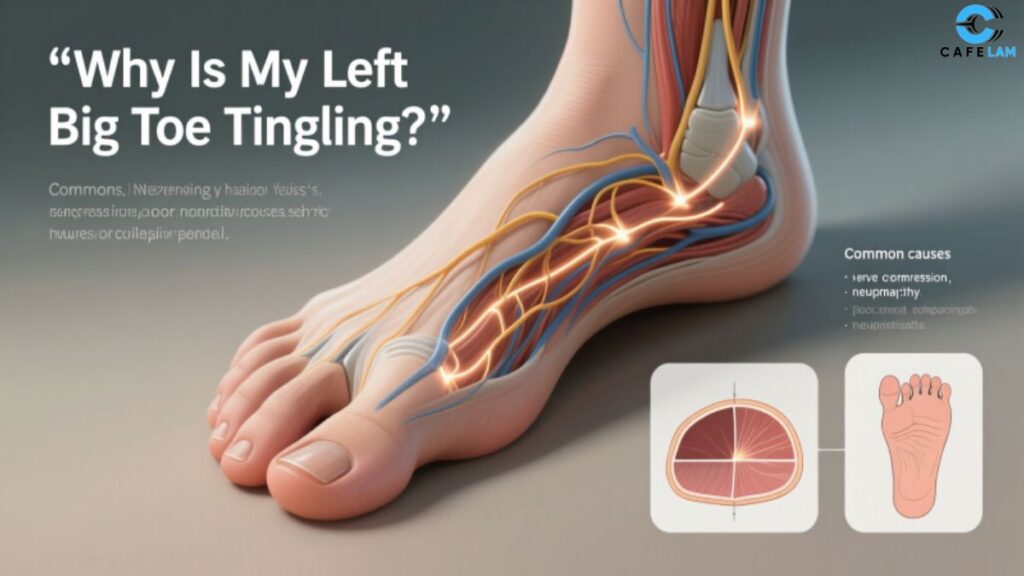Ever noticed an odd tingling sensation in your left big toe that just won’t go away? You’re not alone. This peculiar feeling can range from a mild annoyance to a concerning symptom that disrupts your daily activities.
Tingling in your left big toe might seem like a minor issue, but it can signal various underlying conditions that deserve attention. Understanding the root causes, recognizing warning signs, and knowing when to seek medical help can make all the difference in getting proper treatment and preventing complications.
This comprehensive guide explores everything you need to know about left big toe tingling, from common causes to effective treatment strategies that can help you find relief.
Common Causes of Tingling in Left Big Toe
Nerve Compression and Damage
Nerve-related issues are among the most frequent culprits behind tingling sensations. When nerves become compressed or damaged, they send mixed signals to your brain, creating that familiar pins-and-needles feeling.
Sciatica often causes tingling that radiates from your lower back down to your toes. The sciatic nerve, which runs from your spine to your feet, can become compressed due to herniated discs, bone spurs, or tight muscles. This compression frequently affects one side of your body, explaining why you might experience tingling specifically in your left big toe.
Morton’s neuroma involves thickening of tissue around nerves leading to your toes. While it commonly affects the area between your third and fourth toes, it can sometimes impact your big toe, causing persistent tingling and discomfort.
Circulation Problems
Poor blood flow to your extremities can create tingling sensations as your tissues struggle to receive adequate oxygen and nutrients.
Peripheral artery disease (PAD) narrows blood vessels in your legs and feet, reducing circulation. This condition typically develops gradually and affects millions of people, particularly those over 50 or with risk factors like smoking and diabetes.
Blood clots or varicose veins can also impair circulation, leading to tingling, numbness, or cramping in your toes and feet.
Diabetes and Metabolic Conditions
Diabetic neuropathy represents one of the most serious causes of toe tingling. High blood sugar levels over time can damage nerves throughout your body, with feet and toes being particularly vulnerable areas.
This condition often starts with tingling in your toes and gradually progresses up your feet. Early detection and proper diabetes management are crucial for preventing permanent nerve damage.
Vitamin B12 deficiency can also cause nerve problems that manifest as tingling in your extremities. This vitamin is essential for healthy nerve function, and deficiency can develop due to poor diet, certain medications, or absorption problems.
Injuries and Physical Trauma
Direct injury to your toe, foot, or leg can damage nerves and cause ongoing tingling. Even seemingly minor injuries like stubbing your toe hard or dropping something heavy on your foot can create lasting nerve irritation.
Repetitive stress injuries from activities like running, dancing, or wearing ill-fitting shoes can gradually damage nerves and create chronic tingling sensations.
Recognizing Associated Symptoms
Tingling in your left big toe rarely occurs in isolation. Pay attention to these accompanying symptoms that can help identify the underlying cause:
Numbness or burning sensations often accompany tingling, particularly in cases of nerve damage or diabetes-related complications. You might notice difficulty feeling temperature changes or texture differences when touching objects with your toe.
Pain or cramping in your foot, leg, or lower back can indicate nerve compression issues like sciatica or spinal problems. The pain might worsen with certain movements or positions.
Color changes in your toe or foot, such as bluish, reddish, or pale coloration, often point to circulation problems that require medical evaluation.
Ready to take things further? Discover our full library of content.
Diagnostic Approaches
Healthcare providers use various methods to identify the root cause of your tingling symptoms.
Medical History and Physical Examination
Your doctor will start with a comprehensive review of your symptoms, medical history, and lifestyle factors. They’ll examine your feet, check your reflexes, and test your sensation using simple tools like tuning forks or monofilaments.
Diagnostic Tests
| Test Type | Purpose | What It Reveals |
| Blood Tests | Check glucose, vitamin levels, inflammation markers | Diabetes, vitamin deficiencies, autoimmune conditions |
| Nerve Conduction Studies | Measure nerve signal speed and strength | Nerve damage location and severity |
| MRI or CT Scans | Visualize spine and soft tissues | Disc problems, nerve compression |
| Doppler Ultrasound | Assess blood flow | Circulation problems, blood clots |
| X-rays | Check bone structure | Fractures, arthritis, structural issues |
Specialized Testing
Electromyography (EMG) measures electrical activity in your muscles and can help identify nerve damage patterns. Ankle-brachial index testing compares blood pressure in your arms and ankles to detect circulation problems.
Treatment Options for Left Big Toe Tingling
Lifestyle Modifications
Making targeted lifestyle changes can significantly improve your symptoms and prevent progression.
Proper footwear plays a crucial role in reducing nerve compression and improving circulation. Choose shoes with adequate toe room, proper arch support, and cushioning. Avoid high heels or tight-fitting shoes that can compress nerves.
Regular exercise improves circulation and helps manage conditions like diabetes that contribute to nerve problems. Low-impact activities like swimming, walking, or cycling can be particularly beneficial.
Blood sugar management is essential if diabetes is contributing to your symptoms. Work with your healthcare provider to maintain stable glucose levels through diet, exercise, and medication when necessary.
Medical Treatments
Medications can help manage pain and improve nerve function. Options include anti-seizure medications like gabapentin, tricyclic antidepressants, or topical treatments containing capsaicin or lidocaine.
Physical therapy can help improve circulation, strengthen muscles, and teach you exercises to reduce nerve compression. Your therapist might also use techniques like ultrasound or electrical stimulation.
Injections containing corticosteroids or anesthetics can provide relief for nerve compression issues, particularly when conservative treatments haven’t been effective.
Alternative Therapies
Acupuncture has shown promise in treating nerve-related tingling and can be used alongside conventional treatments. Massage therapy can improve circulation and reduce muscle tension that contributes to nerve compression.
Prevention Strategies
Taking proactive steps can help prevent tingling in your left big toe from developing or worsening.
Maintain healthy blood sugar levels if you have diabetes or prediabetes. Regular monitoring, medication compliance, and lifestyle management are key components of prevention.
Stay physically active to promote good circulation and maintain healthy nerve function. Even simple activities like wiggling your toes or rotating your ankles throughout the day can help.
Protect your feet from injury by wearing appropriate footwear for different activities and avoiding walking barefoot in areas where you might step on sharp objects.
Manage your weight to reduce pressure on nerves and improve circulation. Extra weight can contribute to conditions like diabetes and increase pressure on spinal nerves.
When to Seek Medical Attention
Certain warning signs indicate that your tingling requires immediate medical evaluation.
Sudden onset of severe tingling, especially if accompanied by weakness, confusion, or difficulty speaking, could indicate a stroke or other serious neurological emergency.
Progressive worsening of symptoms over days or weeks, particularly if spreading to other areas of your foot or leg, suggests an underlying condition that needs treatment.
Associated symptoms like severe pain, open wounds, color changes, or signs of infection require prompt medical attention to prevent complications.
Diabetes-related concerns warrant immediate evaluation if you have diabetes and develop new or worsening foot symptoms, as these can progress rapidly to serious complications.
Conclusion
Tingling in your left big toe might start as a minor annoyance, but understanding its potential causes empowers you to take appropriate action. Whether the underlying issue involves nerve compression, circulation problems, or metabolic conditions like diabetes, early recognition and treatment can prevent complications and improve your quality of life.
Remember that persistent or worsening symptoms always warrant medical evaluation. Your healthcare provider can perform appropriate tests, identify the root cause, and develop a treatment plan tailored to your specific situation.
Take charge of your health by maintaining good foot care habits, managing underlying health conditions, and staying alert to changes in your symptoms. With proper attention and care, most causes of toe tingling can be effectively managed.
Frequently Asked Questions
Q: Can tight shoes cause permanent tingling in my left big toe?
A: While tight shoes can cause temporary tingling, permanent nerve damage from footwear alone is rare but possible with prolonged compression.
Q: Is tingling in just one toe ever a sign of a heart problem?
A: Isolated toe tingling is rarely related to heart issues, though poor circulation from heart conditions can sometimes affect extremities.
Q: Can stress or anxiety cause tingling in my left big toe?
A: Yes, stress and anxiety can cause tingling sensations throughout your body, including isolated areas like a single toe.
Q: Does tingling in my left big toe mean I definitely have diabetes?
A: No, while diabetic neuropathy is one cause, many other conditions can cause toe tingling, so proper medical evaluation is necessary.
Q: Can sleeping position cause tingling that lasts all day in my left big toe?
A: Poor sleeping positions can compress nerves temporarily, but persistent all-day tingling usually indicates a more significant underlying issue.







